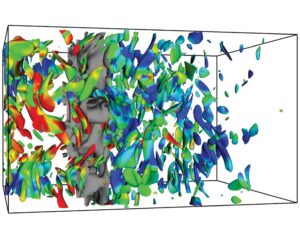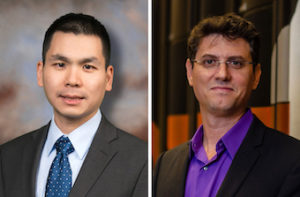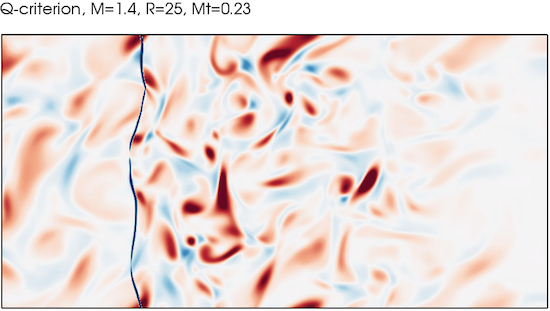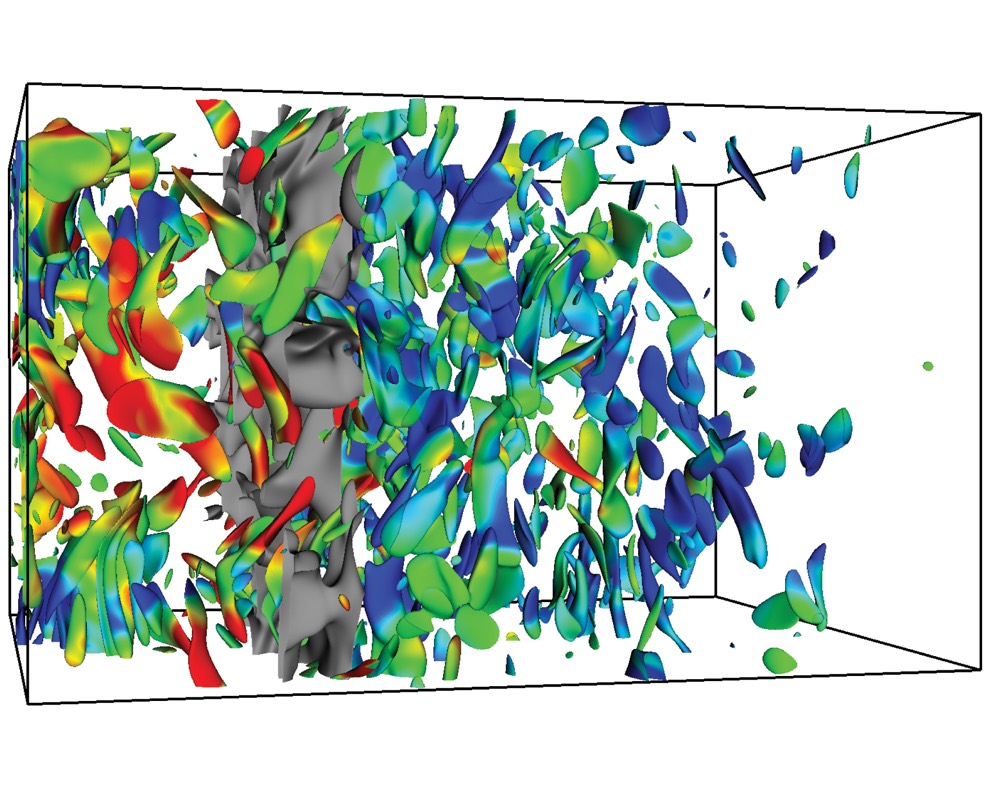
A new theoretical framework was developed and tested using the Stampede2 supercomputer to understand turbulent jumps of mean thermodynamic quantities, shock structure and amplification factors. Turbulence comes in from the left in this image, hitting the shock, and leaving the domain from the right. This three-dimensional picture shows the structure of enstrophy and colored by local Mach number with the shock at gray. Credit: Chang-Hsin Chen, TAMU.
In this special guest feature, Jorge Salazar from TACC writes that Researchers are using XSEDE supercomputers to better understand shock turbulence interactions.
This may come as a shock, if you’re moving fast enough. The shock being shock waves. A balloon’s ‘pop’ is shock waves generated by exploded bits of the balloon moving faster than the speed of sound. Supersonic planes generate a much louder sonic ‘boom,’ also from shock waves. Farther out into the cosmos, a collapsing star generates shock waves from particles racing near the speed of light as the star goes supernova. Scientists are using supercomputers to get a better understanding of turbulent flows that interact with shock waves. This understanding could help develop supersonic and hypersonic aircraft, more efficient engine ignition, as well as probe the mysteries of supernova explosions, star formation, and more.
We proposed a number of new ways in which shock turbulence interactions can be understood,” said Diego Donzis, an associate professor in the Department of Aerospace Engineering at Texas A&M University. Donzis co-authored the study, “Shock-Turbulence Interactions at High Turbulence Intensities,” published May of 2019 in the Journal of Fluid Mechanics. “We proposed that, instead of treating the shock as a discontinuity, one needs to account for its finite thickness as in real life which may be involved as a governing parameter in, for example, amplification factors,” Donzis said.

Shock turbulence study co-authors Chang Hsin Chen (L) and Diego Donzis (R), pictured with the Stampede2 supercomputer. Drs. Chen and Donzis are both with the Department of Aerospace Engineering, Texas A&M University. Credit: TACC.
The dominant theoretical framework for shock turbulence interactions goes back to the 1950s, developed by Herbert Ribner while at the University of Toronto, Ontario. His work supported the understanding of turbulence and shocks interactions with a linear, inviscid theory, which assumes the shock to be a true discontinuity. The entire problem can thus be reduced to something mathematically tractable, where the results depend only on the shock’s Mach number, the ratio of a body’s speed to the speed of sound in the surrounding medium. As turbulence goes through the shock, it is typically amplified depending on the Mach number.
Experiments and simulations by Donzis and colleagues suggested this amplification depends also on the Reynolds Number, a measure of how strong the turbulence is, and the turbulent Mach number. “We proposed a theory that combined all of these into a single parameter,” Donzis said. “And when we proposed this theory a couple of years ago, we didn’t have well-resolved data at very high resolution to test some of these ideas.”
Enter Stampede2, an 18 petaflop supercomputer at the Texas Advanced Computing Center, part of The University of Texas at Austin. Stampede2 is the most powerful computer in the U.S. for open science research, where the results are made freely available. Donzis was awarded compute time on Stampede2 through XSEDE, the Extreme Science and Engineering Discovery Environment. Both Stampede2 and XSEDE are funded by the National Science Foundation.
On Stampede2, we ran a very large data set of shock turbulence interactions at different conditions, especially at high turbulence intensity levels, with a degree of realism that is beyond what is typically found in the literature in terms of resolution at the small scales, in terms of the order of the scheme that we used,” Donzis said. “Thanks to Stampede2, we can not only show how amplification factors scale, but also under what conditions we expect Ribner’s theory to hold, and under what conditions our previously proposed scaling is the more appropriate one.”
Study lead author Chang Hsin Chen added that, “We also looked at the structure of the shock and, through highly resolved simulations, we were able to understand how turbulence creates holes on the shock. This was only possible due to the computational power provided by Stampede2.” Chen is a postdoctoral researcher in the National Aerothermochemistry Laboratory at Texas A&M University. His research focuses on compressible turbulence and shock waves, and high performance computational fluid dynamics.

Another simulated view of turbulence coming from the left, hitting the shock, and leaving the domain from the right. The two-dimensional picture is Q-criterion and the shock is the thin blue line. Credit: Credit: Chang-Hsin Chen, TAMU.
Donzis furthered that “Stampede2 is allowing us to run simulations, some of them at unprecedented levels of realism, in particular the small-scale resolution that we need to study processes at the very small scales of turbulent flows. Some of these simulations run on half of the machine, or more, and sometimes they take months to run.”
What’s more, the scientists also explored the so-called shock jumps, which are abrupt changes in pressure and temperature as matter moves across a shock.
“In this study we developed and tested a new theoretical framework to understand, for example, why an otherwise stationary shock starts moving when the incoming flow is turbulent,” Donzis said. This implies that the incoming turbulence deeply alters the shock.
The theory predicts, and the simulations on Stampede2 confirm that the pressure jumps change, and how they do so when the incoming flow is turbulent. This is an effect that is actually not accounted for in the seminal work by Ribner, but now we can understand it quantitatively,” Donzis said.
Making progress in understanding when turbulence meets shocks didn’t come easy. Extreme resolution on the order of billions of grid points are needed to capture the sharp gradients of a shock at high Reynolds number. “While we are limited by how much we can push the parameter range on Stampede2 or any other computer for that matter, we have been able to cover a very large space in this parameter space, spanning parameter ranges beyond what has been done before,” Donzis said.
The input/output (I/O) also turned out to be challenging in writing the data to disk at very large core counts. “This is one instance in which we took advantage of the Extended Collaborative Support Services (ECSS) from XSEDE, and we were able to successfully optimize our strategy,” Donzis said. “We are now confident that we can keep increasing the size of our simulations with the new strategy and keep doing I/O at a reasonable computational expense.”
Donzis is no stranger to XSEDE, which he’s used for years back when it was called Teragrid, to develop his group’s codes – starting with the LeMieux system at the Pittsburgh Supercomputing Center; Blue Horizon at the San Diego Supercomputer Center; Kraken at the National Institute for Computational Sciences; and now on Stampede1 and Stampede2 at TACC.
A number of the successes that we have today are because of the continued support of XSEDE, and Teragrid, for the scientific community. The research we’re capable of doing today and all the success stories are in part the result of the continuous commitment by the scientific community and funding agencies to sustain a cyberinfrastructure that allows us to tackle the greatest scientific and technological challenges we face and may face in the future. This is true not just for my group, but perhaps also for the rest of the scientific computing community in the US. I believe the XSEDE project and its predecessors in this sense have been a tremendous enabler,” Donzis said.
Donzis is a firm believer that advances in high performance computing (HPC) translate directly to benefits for all of society. “Any impact in HPC will have repercussions in transportation, industrial processes, manufacturing, defense, essentially the everyday life of ordinary people, as most of our lives are infused with technology products and services that at some stage or another benefit from numerical computations of different scales,” Donzis said. And advances in the understanding of turbulence impact a broad range of applications, he added.
Said Donzis: “Advances in the understanding of shock turbulence interactions could lead to supersonic and hypersonic flight, to make them a reality for people to fly in a few hours from here to Europe; space exploration; and even our understanding of the structure of the observable universe. It could help answer, why are we here? More down to Earth, understanding turbulence in compressible flows could lead to great improvements in combustion efficiency, drag reduction and general transportation.”
Source: TACC




